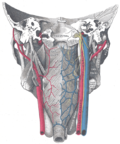Stylopharyngeus muscle
Stylopharyngeus Muscle
The Stylopharyngeus muscle is a slender muscle in the human body that plays a crucial role in the process of swallowing. It is part of the pharyngeal muscles group and is involved in elevating the pharynx and larynx. This article provides a comprehensive overview of the anatomy, function, innervation, and clinical significance of the Stylopharyngeus muscle.
Anatomy[edit]
The Stylopharyngeus muscle originates from the styloid process of the temporal bone. It descends downward and medially, between the Superior and Middle pharyngeal constrictor muscles, to insert into the posterior border of the thyroid cartilage and the pharyngeal wall. This muscle is unique because it is the only muscle innervated by the Glossopharyngeal nerve (CN IX).
Function[edit]
The primary function of the Stylopharyngeus muscle is to elevate the pharynx and larynx during swallowing and speaking. By doing so, it helps in the passage of food and liquid from the mouth to the esophagus. It also contributes to the widening of the pharynx which facilitates the passage of a food bolus.
Innervation[edit]
The Stylopharyngeus muscle is innervated by the Glossopharyngeal nerve (CN IX). This nerve provides motor innervation, which enables the muscle to contract and perform its function in the swallowing process.
Clinical Significance[edit]
Dysfunction of the Stylopharyngeus muscle can lead to swallowing difficulties, known medically as Dysphagia. This can result from nerve damage, muscle disorders, or structural abnormalities. Understanding the anatomy and function of the Stylopharyngeus muscle is crucial for diagnosing and treating conditions related to swallowing disorders.
Related Conditions[edit]
- Dysphagia: Difficulty in swallowing.
- Eagle's syndrome: A condition characterized by recurrent pain in the oropharynx and face due to an elongated styloid process or calcified stylohyoid ligament.
- Pharyngitis: Inflammation of the pharynx, which can indirectly affect the function of the Stylopharyngeus muscle.
See Also[edit]
References[edit]
<references/>
-
Stylopharyngeus muscle
-
Epiglottic cartilage
-
Stylopharyngeus muscle
-
Stylopharyngeus muscle
-
Stylopharyngeus muscle
-
Stylopharyngeus muscle
-
Stylopharyngeus muscle
-
Stylopharyngeus muscle
-
Stylopharyngeus muscle
-
Stylopharyngeus muscle
-
Stylopharyngeus muscle
Ad. Transform your life with W8MD's Budget GLP-1 injections from $75


W8MD offers a medical weight loss program to lose weight in Philadelphia. Our physician-supervised medical weight loss provides:
- Weight loss injections in NYC (generic and brand names):
- Zepbound / Mounjaro, Wegovy / Ozempic, Saxenda
- Most insurances accepted or discounted self-pay rates. We will obtain insurance prior authorizations if needed.
- Generic GLP1 weight loss injections from $75 for the starting dose.
- Also offer prescription weight loss medications including Phentermine, Qsymia, Diethylpropion, Contrave etc.
NYC weight loss doctor appointmentsNYC weight loss doctor appointments
Start your NYC weight loss journey today at our NYC medical weight loss and Philadelphia medical weight loss clinics.
- Call 718-946-5500 to lose weight in NYC or for medical weight loss in Philadelphia 215-676-2334.
- Tags:NYC medical weight loss, Philadelphia lose weight Zepbound NYC, Budget GLP1 weight loss injections, Wegovy Philadelphia, Wegovy NYC, Philadelphia medical weight loss, Brookly weight loss and Wegovy NYC
|
WikiMD's Wellness Encyclopedia |
| Let Food Be Thy Medicine Medicine Thy Food - Hippocrates |
Medical Disclaimer: WikiMD is not a substitute for professional medical advice. The information on WikiMD is provided as an information resource only, may be incorrect, outdated or misleading, and is not to be used or relied on for any diagnostic or treatment purposes. Please consult your health care provider before making any healthcare decisions or for guidance about a specific medical condition. WikiMD expressly disclaims responsibility, and shall have no liability, for any damages, loss, injury, or liability whatsoever suffered as a result of your reliance on the information contained in this site. By visiting this site you agree to the foregoing terms and conditions, which may from time to time be changed or supplemented by WikiMD. If you do not agree to the foregoing terms and conditions, you should not enter or use this site. See full disclaimer.
Credits:Most images are courtesy of Wikimedia commons, and templates, categories Wikipedia, licensed under CC BY SA or similar.
Translate this page: - East Asian
中文,
日本,
한국어,
South Asian
हिन्दी,
தமிழ்,
తెలుగు,
Urdu,
ಕನ್ನಡ,
Southeast Asian
Indonesian,
Vietnamese,
Thai,
မြန်မာဘာသာ,
বাংলা
European
español,
Deutsch,
français,
Greek,
português do Brasil,
polski,
română,
русский,
Nederlands,
norsk,
svenska,
suomi,
Italian
Middle Eastern & African
عربى,
Turkish,
Persian,
Hebrew,
Afrikaans,
isiZulu,
Kiswahili,
Other
Bulgarian,
Hungarian,
Czech,
Swedish,
മലയാളം,
मराठी,
ਪੰਜਾਬੀ,
ગુજરાતી,
Portuguese,
Ukrainian











